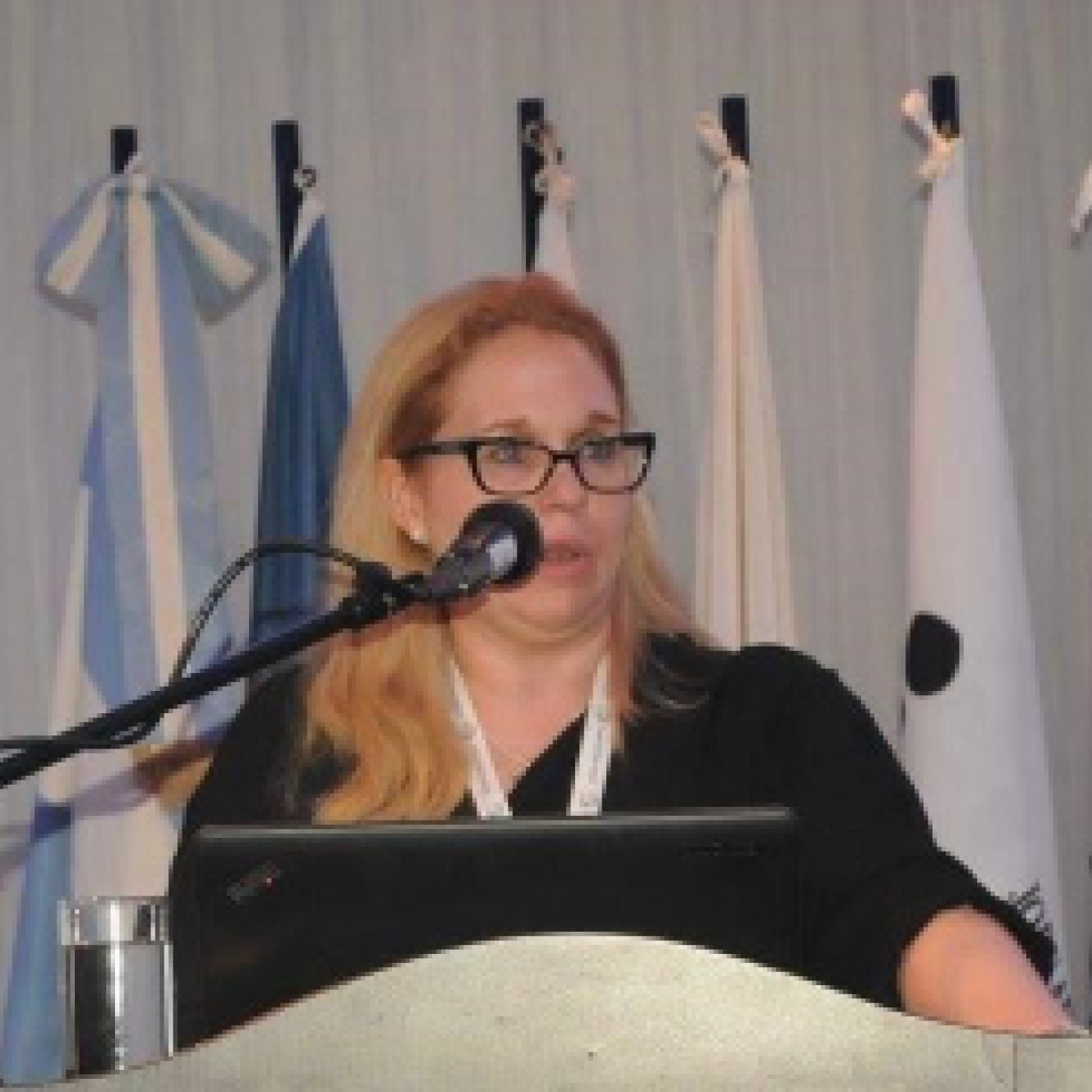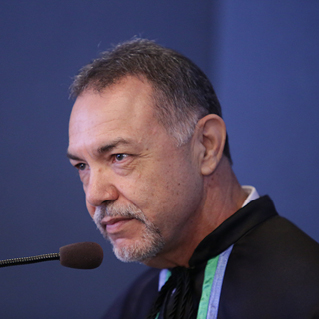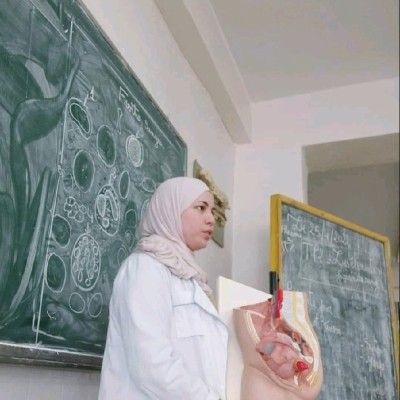
Title: Nanoplastics: hypotheses on their nanotoxic effects
Plenary Speaker
Prof. Maria Cecilia Colautti
National Defense University, Argentina
Abstract
Nanoplastics, which are plastic particles smaller than 1 micron in size, have raised significant concerns regarding their potential toxicity to both environmental and human health. The nanoscale size of these particles allows them to interact with biological systems in unique and potentially hazardous ways. Here are several key points regarding the nanotoxicity of nanoplastics:
- Cellular and Molecular Interactions: Nanoplastics can be easily ingested or inhaled due to their small size. Once inside the body, they can cross cellular membranes and interact with cellular components. This interaction can lead to oxidative stress, inflammation, and even damage to DNA, proteins, and membranes.
- Bioaccumulation and Biomagnification: Nanoplastics can accumulate in various organisms, including marine animals, potentially leading to biomagnification up the food chain. This means that organisms at higher trophic levels could be exposed to higher concentrations of nanoplastics, posing greater risks to their health and that of any predators, including humans.
- Persistence in the Environment: Nanoplastics are highly resistant to degradation, making them persistent environmental pollutants. Their small size and large surface area also enhance their potential to adsorb and carry other contaminants, such as heavy metals and organic pollutants, further complicating their environmental impact.
- Impact on Aquatic Life: Studies have shown that nanoplastics can affect aquatic organisms, such as fish and plankton, by causing physical blockages, chemical imbalances, and even altering behavior and reproductive functions.
- Human Health Risks: While research is still emerging, the inhalation and ingestion of nanoplastics could pose direct risks to human health. Concerns include potential impacts on lung and gut health, as well as the broader implications of chronic inflammation and immune responses.
Overall, the growing prevalence of nanoplastics in the environment necessitates deeper research to fully understand their impacts and to develop strategies to mitigate their presence and effects. Regulations and innovative waste management solutions are also critical in addressing the issue of nanoplastic pollution.
Biography
María Cecilia Colautti is Doctor of Medicine from the Inter-American Open University (UAI), Post¬graduate Studies in Pain Medicine from Favaloro University. Specialist in Occupational Medicine from the Medical College of the Province of Buenos Aires. Specialist in Forensic Medicine from the Argentine Catholic University (UCA). Master’s degree in Occupational Health and Safety. Preven¬tion of Occupational Risks. Polytechnic University of Catalonia. Full Professor in the Master’s Pro¬gram on Safety, Health, and Hygiene at the Faculty of Engineering of the Argentine Army. National Defense University. She has an extensive professional experience focused on integrated management systems in Safety, Health, Environment, and Quality processes. Certification in ISO 9001, ISO 45001, ISO 14001, ISO 18001, Occupational Safety and Health. ISO 14000 Environmental Management. . She is the author of the first book in Spanish language about Fundamentals of Nanotechnology and Nanotoxicity.

Title: 2D Heterostructures & 2D Ferroelectrics
Plenary Speaker
Prof. Andrew T. S. Wee
Department of Physics, National University of Singapore, Singapore
Abstract
I will talk about two of our recent projects on 2D materials. First, we report a phase-selective inplane heteroepitaxial method to grow semiconducting H-phase CrSe2 (Nat. Comm. 2024). The lattice-matched MoSe2 nanoribbons are utilized as the in-plane heteroepitaxial template to seed the growth of H-phase CrSe2 with the formation of MoSe2- CrSe2 heterostructures. Scanning tunneling microscopy and non-contact atomic force microscopy studies reveal the atomically sharp heterostructure interfaces and the characteristic defects of mirror twin boundaries emerging in the H-phase CrSe2 monolayers. Second, I will, report the observation of a single-element ferroelectric state in a black phosphorus-like bismuth layer, in which the ordered charge transfer and the regular atom distortion between sublattices happen simultaneously. Instead of a homogenous orbital configuration that ordinarily occurs in elementary substances, we found the Bi atoms in a black phosphorous-like Bi monolayer maintain a weak and anisotropic sp orbital hybridization, giving rise to the inversion-symmetry-broken buckled structure accompanied with charge redistribution in the unit cell. As a result, the in-plane electric polarization emerges in the Bi monolayer. Using the in-plane electric field produced by scanning probe microscopy, ferroelectric switching is further visualized experimentally. Owing to the conjugative locking between the charge transfer and atom displacement, we also observe the anomalous electric potential profile at the 180° tail-to-tail domain wall induced by competition between the electronic structure and electric polarization
Biography
Andrew Wee is a Class of ’62 Professor of Physics at the National University of Singapore (NUS), He was previously Dean of Science and Vice President (University and Global Relations). His research interests are in surface and nanoscale science, scanning tunneling microscopy (STM) and synchrotron radiation studies of the molecule-substrate interface, graphene and related 2D materials. He was a Commonwealth Fellow as well as a Rhodes Scholar at the University of Oxford, where he received his received his DPhil (1990). He holds a Bachelor of Arts (Honours) in Physics (1994) as well as a Masters degree from the University of Cambridge. He serves or has served on several journal editorial boards

Title: The Dire Consequences of Nano Tech Development and Transhumanism Morphology
Keynote Speaker
Bryan Pelletier
Bryan396 Nano Tech Research Project, Canada
Abstract
My presentation will provide multiple examples of the nanotechnology self assembling polymers, nanotechnology programmable magnetic carbon and nano tech components that have saturated the human body, making it a biotech frequency transceiver and computer network. This is creating an alteration of our DNA and genetics, the result of MRNA genetic transfers and DNA attachments. All life on the planet is at a critical stage of nano tech saturation, permanent genetic mutating and biological alterations.
In 2012, during research, I encountered a controversial condition termed Morgellons, that appeared to be the same as those that the nano tech developers were displaying in their lab reports.
In comparing the images of the Morgellons with the Nano Tech researchers published achievements, I saw them as being similar and when observing them under microscope, concluded that these were bio nano tech assemblies and components.
My investigations found these to be consistent with the samples taken from the research papers on nano tech, the morgellons sample pictures and the ones i have found in the human body, and documented.of pictures and explanatory videos.
The removal of these nano nodes has reversed many lifelong health issues, some had repeated medical interventions, thus improving health and vitality.
There is an expected response, of auto rejection, at these findings, and these will disperse as the findings are reviewed and analyzed.
Any hesitation of accepting the information as factual and accurate, will dissipate as the extensive documentation is reviewed.
My 12 years of focused research has logged 10's of thousands of research hours, along with deep reflective analytical contemplation and personal observations, to arrive at these findings and conclusions.
What I have found,and offer evidence of, is substantiating and indisputable proof of the claims I am making about the genetic disruptions, along with an explanation and understanding of what processes are involved.
My discoveries have traced the nano tech loading, of life long loading, back to childhood medical issues, as they reappeared and were removed.
The lifelong accumulation of the nano materials, which is responsible for many health, if not all health issues, we are now experiencing from the nano tech loads, that have manifested as unusual new outbreaks of diseases. .
My claims are easily verifiable by anyone who takes the time to inspect their own bodies with an inexpensive USB microscope, available on the internet for $30.
One can easily identify the red and blue colored threads that are embedded in the polymer hydrogel layers that coat the body and shrink with a high volume of water evaporation, from the hydrogels on the tissue surfaces, at a magnification of 200x.
There are ample documents that they have published claiming to use the nano tech in geo engineering, in agriculture and meat production.
I will be assembling a detailed overview of each stage of the nano build processes, as soon as possible, and prior to the conference for reference and to provide a foundation to work from
Biography
Xerox Computer Tech last half of the 1980's Home Contractor and Caretaker for the money privileged in the early to mid 90's Mid 90's til 2004 Motivated by a Mid life health crisis, started my deep spiritual studies of the Metaphysical Realms, Miracles Manifested, Quantum Physics, Medical Investigations and many obscured teachings and understandings from ancient and obscure texts that have faded from public knowledge and hidden overtime. 2004 til 2012 I Started a Far Infrared Massage Bed, and subtle body energy systems, Health Clinic, with a Chinese partner who was well versed in acupuncture and Chinese healing techniques. I continued Spiritual Studies with Body and Mine Energy and Control System, related to frequencies and alternate healing modalities detached from main stream alopathic protocols and belief systems. 2010 Published Zero Point Energy Document on Frequencies and Manifestation, 2011 Discovered the bio nano load in the body and saw it as Self Assembling Polymers. Produced the initial Nano Tech Document. ' Chemtrails Morgellons', Self Assembling Polymers and Nano Technology.' 2011 til 2020 Nano Tech Research and Experiment. 2020 Formulation of the Ionic Formulas and Compounds 2020-2023 Continued formulation and testing of effective nano tech neutralization and detoxification. Currently: Ongoing testing of the formulas and tweaking the process and continuing research, now dedicated to nano tech research and public awareness for the last 12 yrs.@ 12 - 18 hrs daily, with over 100,000 Hrs. of research time invested.

Title: Circumventing Challenges in CVD Graphene Coating on Mild Steels for Remarkable and Durable Corrosion Resistance
Plenary Speaker
Prof. Raman Singh
Department of Mechanical & Aerospace Engineering, Department of Chemical & Biological Engineering, Monash University, Vic 3800, Australia
Abstract
Graphene has triggered unprecedented research excitement for its exceptional characteristics. The most relevant properties of graphene as corrosion resistance barrier are its remarkable chemical inertness and impermeability and toughness, i.e., the requirements of an ideal surface barrier coating for corrosion resistance, thus, an interest in graphene coating as a disruptive approach to corrosion mitigation. However, the extent of corrosion resistance due to chemical vapour deposition (CVD) graphene coatings has been found to vary considerably in different studies. The author’s group demonstrated the ultra-thin graphene coatings developed on copper and nickel by CVD to improve corrosion resistance of the metals by two orders of magnitude in aggressive aqueous chloride environments. In contrast, other reports suggest the graphene coating to actually enhance corrosion rate of copper, particularly during extended exposures. Author’s group has investigated the reasons for such contrast in corrosion resistance due to graphene coating as reported by different researchers, and on the basis of the findings, they have succeeded in developing multilayer graphene coatings that conferred durable corrosion resistance to copper and nickel in the aggressive chloride environment.
Corrosion and its mitigation costs dearly (any developed economy loses 3-4% of GDP due to corrosion, which translates to ~$250b to annual loss USA). In spite of traditional approaches of corrosion mitigation (e.g., use of corrosion resistance alloys such as stainless steels and polymeric coatings), loss of infrastructure due to corrosion continues to be a vexing problem. Therefore, it is technologically as well as commercially attractive to explore graphene coating as a disruptive approach to durable corrosion mitigation. However, developing graphene coating on the most common engineering alloy, mild steel by CVD is a non-trivial challenge. The presentation will discuss the challenges, and their successful circumvention that enabled graphene coatings on mild steel, and presents results demonstrating durable and remarkable corrosion resistance of graphene-coated mild steel
Biography
Professor Raman Singh’s primary research interests are in the relationship of Nano/microstructure and Environment-assisted degradation and fracture of metallic and composite materials, and Nanotechnology for Advanced Mitigation of such as graphene coatings. He is a senior professor at Monash University, Australia. He is/was a Guest Professor at ETH Zurich, Switzerland (2020, 2023, 2024), US Naval Research Lab, Indian Institute of Science, and University of Connecticut. He worked as a scientist at Indian Atomic Energy and as a post-doc fellow at UNSW/Australia. His professional distinctions and recognitions include: Guest Professor of ETH Zurich, Editor of a book on Cracking of Welds (CRC Press), Lead Editor of a book on Non-destructive Evaluation of Corrosion (Wiley), Editor-in-Chief of an Elsevier and two MDPI journals, leader/chairperson of a few international conferences and numerous plenary/keynote lectures at international conferences, over 265 peer-reviewed international journal publications and 15 book chapter, and several competitive research grants He has supervised 60 PhD students

Title: Exploring the Impact of Nanomorphology in Biological Assays
Plenary Speaker
Prof. Paulo C. De Morais
Genomic Sciences and Biotechnology, Catholic University of Brasília, Brasília, DF, Brazil
Abstract
The presentation will be focused on exploring mathematical models which are suitable to describe cargo-delivery using nanomaterials (NMs) while assessing information from in vitro assays. Presently, less than about 0.5% of the accumulated world’s reports involving in vitro assays include a mathematical model, but this fraction is growing up steeply worldwide in recent years, signaling the recent trend in handling the biological data in a more comprehensive way. The starting mathematical model for in vitro assays is the Hill equation, herein described as a Hill-inspired approach, characterized by its Hill coefficient. In this case, the morphological parameters of the NMs are included into the original Hill coefficient, which is interpreted as the number of ligand sites in the MNM’s surface which are available for binding to receptors onto the cell membrane/
Biography
Professor De Morais, PhD, was full Professor of Physics at University of Brasilia (UnB) – Brazil up to 2013, Appointed as: UnB’s Emeritus Professor (2014); Visiting Professor at HUST – China (2012-2015); Distinguished Professor at AHU – China (2016-2019); Full Professor at Catholic University of Brasília – Brazil (2018); CNPq-1A Research Fellow since 2010; 2007 Master Research Prize from UnB. He held two-years (1987-1988) post-doc position with Bell Communications Research – USA and received his Doctoral degree in Solid State Physics (1986) from the Federal University of Minas Gerais – Brazil. He has published about 500 papers (Web of Science).

Title: Cellular characterization of extracellular mitochondria transfer
Keynote Speaker
Dr. Zahra Al Amir Dache
INSERM U1316, CNRS UMR 7057, Université Paris Cité, France
Abstract
Mitochondria, considered as the powerhouse of the cell, have been found outside the cells from which they originate under certain pathological conditions, suggesting a role in intercellular communication. In 2019, we have demonstrated, for the first time, the presence of intact mitochondria in healthy individuals’ bloodstream, in normal physiological state. Today, through the development of highly sensitive luminescence-based assays, we investigate the qualitative and quantitative transfer of extracellular mitochondria between cells. Our findings demonstrated the uptake of extracellular mitochondria by recipient cells, their escape from degradation pathways, their cytosolic delivery and potential fusion with the mitochondrial networks. A comprehensive mechanistic study is proposed to elucidate the underlying cellular and molecular mechanisms. These findings not only challenge current research thinking but also offer promising avenues for therapeutic interventions, particularly in diseases where mitochondrial dysfunction is implicated
Biography
Zahra Al Amir Dache holds a Ph.D. in Biology and Health from the University of Montpellier and is currently pursuing a Post-doctoral fellowship at Paris Cité University. With expertise in cellular and molecular biology, she has contributed to several publications in international journals. Her research has focused on the identification of extracellular mitochondria in both, blood samples ex vivo, and extracellular media in vitro. Currently, her work lies in elucidating the cellular and molecular mechanisms underlying the uptake and delivery of these extracellular mitochondria to acceptor cells. These findings hold promise for potential therapeutic interventions, particularly in diseases associated with mitochondrial dysfunction.

Title: Decellularization and Characterization of Lung Tissue and the Investigation of the Effect of Metastasis on the Lung Microenvironment: A Bioengineering Approach
Speaker
Tuana Gürşen
Ege University, Faculty of Engineering, Department of Bioengineering, Izmir, Turkey
Abstract
In my presentation, I will discuss the development and characterization of a three-dimensional (3D) extracellular matrix (ECM) that mimics the lung microenvironment, specifically aimed at advancing our understanding of breast cancer metastasis. This research stems from the need to overcome the limitations of traditional two-dimensional cell cultures and animal models, which often do not accurately represent human physiological responses or ethical research practices.
I will outline the methods used in our study, which involved the decellularization of bovine lung tissue using an optimized protocol that combines chemical, physical, and biological techniques. These include the application of SDS, Triton X-100, and peracetic acid, which have been shown to effectively remove approximately 98% of DNA from the tissues, thereby minimizing cellular remnants while preserving essential ECM components such as collagen, elastin, and sulfated glycosaminoglycans (sGAGs).
The significance of this work lies in the bioengineered ECM's ability to provide a realistic platform for the dynamic study of cancer cell behaviors and interactions within a biomimetic environment. By providing detailed insights into the interactions of metastatic cancer within the lung microenvironment, our study not only enhances the understanding of cancer progression but also aids in the development of targeted therapies.
This approach represents a promising alternative to conventional models, aligning with ethical research practices and offering a cost-effective method for drug development and cancer research. Through this presentation, I hope to convey the potential of bioengineered tissues in improving preclinical models and ultimately contributing to more effective cancer treatments.
Biography
Tuana Gürşen recently graduated from Ege University, where she completed her degree in Bioengineering, finishing second in her department, and is also pursuing a double major in Chemical Engineering. She demonstrated her research capabilities as the principal investigator of a TÜBİTAK-funded project titled "Decellularization and Characterization of Lung Tissue and the Effect of Metastasis on the Lung Microenvironment." Under the guidance of Dr. Özlem Yeşil Çeliktaş at the Biomimetic Microsystems Laboratory, Tuana authored the project proposal and managed its execution, focusing on developing innovative biomaterials to enhance the understanding of cancer metastasis. Additionally, Tuana participated in the 2247-C STAR TUBITAK Intern Researcher Programme, furthering her focus on 3D biomimetic models for cancer invasion. This included extensive work on tissue decellularization and the development of biocompatible materials. Her international experience is marked by her time at the James Watt School of Engineering at the University of Glasgow, where she worked under Professors Jon Cooper and Julien Reboud. Here, she expanded her skills in advanced cell culture techniques, biomaterials, and diagnostic imaging. Tuana has been recognized for her academic excellence with prestigious scholarships such as the TEV Success Scholarship and the Korea Tobacco and Ginseng Corporation (KT&G) Success Scholarship. Her dedication to her field is further exemplified by her proactive approach to learning and application of bioengineering principles in real-world scenarios. Tuana Gürşen is committed to advancing the field of bioengineering, focusing on the practical application of her research to develop innovative medical solutions that improve patient outcomes in healthcare technology.

Title: Nanoparticle Revolution: Transforming Water Treatment for Hydrocarbon and Heavy Metal Pollution Management
Keynote Speaker
Dr. REMITA Feriel
Environmental Research Center, Annaba Algeria
Abstract
The rise of green nanoparticles has revolutionized water treatment approaches, offering Eco-friendly solutions for combating hydrocarbon and heavy metal pollution. Within nanoparticle-driven water treatment facilities, environmentally friendly options like copper oxide (CuO) and zinc oxide (ZnO) play crucial roles in tackling pollutants. These nanoparticles, known for their eco-friendliness, low toxicity, and sustainable production methods, exhibit impressive capabilities in degrading hydrocarbons and adsorbing heavy metals. Utilizing mechanisms such as adsorption, oxidation, and photocatalysis, CuO and ZnO nanoparticles effectively remove contaminants from water treatment systems. Integrating these green nanoparticles into infrastructure promotes scalable and environmentally sustainable purification of contaminated water sources. In conclusion, green nanoparticle-based water treatment have demonstrated their efficacy as a viable solution for hydrocarbon and heavy metal pollution. By utilizing environmentally friendly nanoparticles, these facilities effectively remove contaminants while prioritizing sustainability and eco-friendliness. This successful integration underscores the importance of sustainable solutions in addressing water pollution challenges.
Biography
Dr. Feriel REMITA, holding a Ph.D. in animal ecophysiology from the University of Badji Mokhtar Annaba, and as a researcher at the Environmental Research Center (CRE) in Annaba, my career has been defined by an unwavering passion for environmental preservation. Currently, my work at CRE is centered around an innovative project that explores the application of green nanoparticles as a depollution agent while assessing their impact on cellular health. This pioneering initiative aims to develop sustainable solutions to mitigate pollution issues while safeguarding ecosystem health. My dedication to environmental research and conservation continues to drive me to be a catalyst for a cleaner and healthier future.
“ Will be updated soon...”
“ Will be updated soon...”
+91 9491 456 452
7-89-1-18, NVR LAYOUT, Madanapalle, Andhra Pradesh 517325, India
About Us
Global Scientific Guild organizes conferences and webinars to promote quality research and real world impact in an atmosphere of true international co-operation between scientists, doctors, professors, practitioners, engineers and industry by bringing together the world class renowned personalities to discuss the latest developments and innovations at one common platform.